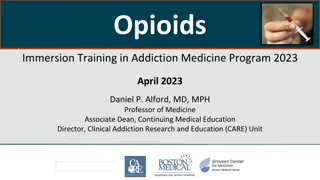Overview of Narcotic Analgesics and Opioids
Narcotic analgesics, such as opiates and opioids derived from opium, interact with specific opioid receptors in the body to produce analgesic effects. Different opioid receptors have varying effects, with mu (MOP) being a good analgesic but with adverse effects, delta (DOP) and kappa (KOP) have nuanced roles, and nociceptin (NOP) not typically inducing analgesia. Endogenous opioid peptides naturally produced in the CNS include enkephalins, dynorphins, endorphins, and possibly nociceptin. Morphine/opioids effects vary, such as CNS depression, miosis, and stimulation. Various agonists, agonist/antagonists, and antagonists are used clinically.
Download Presentation

Please find below an Image/Link to download the presentation.
The content on the website is provided AS IS for your information and personal use only. It may not be sold, licensed, or shared on other websites without obtaining consent from the author.If you encounter any issues during the download, it is possible that the publisher has removed the file from their server.
You are allowed to download the files provided on this website for personal or commercial use, subject to the condition that they are used lawfully. All files are the property of their respective owners.
The content on the website is provided AS IS for your information and personal use only. It may not be sold, licensed, or shared on other websites without obtaining consent from the author.
E N D
Presentation Transcript
NARCOTIC ANALGESICS RP Pandey
Opiates & Opioids Opioid analgesics are purified from the juice of Papaverum somniferum. Unrefined extract is called opium and contains approximately 20 naturally occurring pharmacologically active compounds called opiates (morphine and codeine). Many semisynthetic and synthetic analogs of the opiates have been developed for clinical use. The opioids are narcotics and pure analgecis. Exogenously administered opioids exert their effects by interacting with specific opioid receptors and mimicking naturally occurring molecules known as endogenous opioidpeptides (OP). There are four well defined opioid receptors (mu or MOP, delta or DOP, kappa or KOP and nociceptin or NOP).
mu (MOP) good analgesic effect adverse effects delta (DOP) kappa (KOP) nociceptin (NOP) no typical opioid analgesia. produces anti-opioid effect (prono- ciceptive) poor analgesic effect may modify mu mediated anti- nociception, crosstalk analgesia in several specific locations in the CNS and the periphery but difficult to differentiate MOP and KOP mediated analgesia
Endogenous opioid peptides Endogenous opioid peptides naturally produced in the CNS are enkephalins, dynorphins, endorphin......and possibly nociceptin(aka orphanin FQ).
Morphine/opioid effects CNS depression & miosis CNS stimulation & hypothermia & mydriasis Dogs, monkeys, man Cat, goat, horse, sheep, pig, cow Vomiting in cats and dogs .but not in post op period Opioids like codine, hydrocodone and butorphanol have excellent antitussive effect Opioids decreased response to hypercarbia (mu2 mediated)- decreased ventilation (synergistic with CNS depressants) Stimulate medullary vagal nucleus - bradycardia-responds readily to anticholinergics Initial defecation followed by constipation and ileus Rapid iv inj of morphine histamine hypovolemia, hypotension Suppression of detrussor m decrease urge need to catheterize
Agonist, Agonist/Antagonist or partial agonist, Antagonist Agonist Agonist/Antagoni st or partial agonist Butorphanol Petazocine Buprenorphine Antagonist Morphine Meperidine Fentanyl Etorphine Carfentanil Methadone Codine Naloxone Neltrexone























